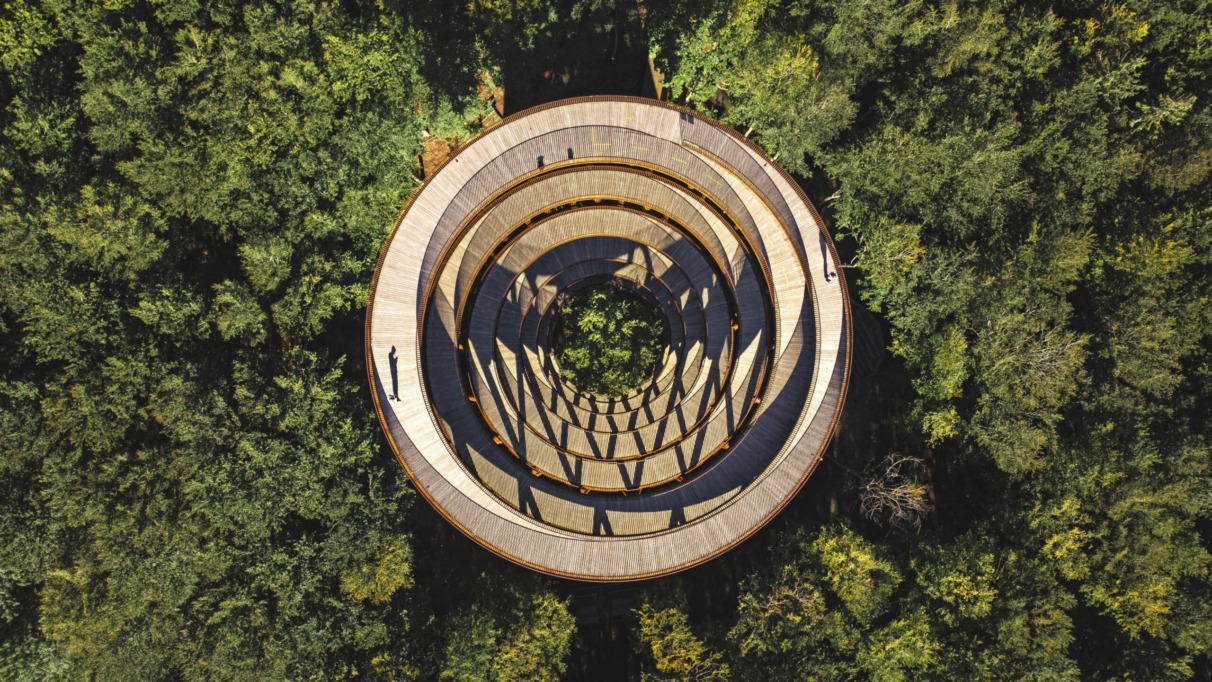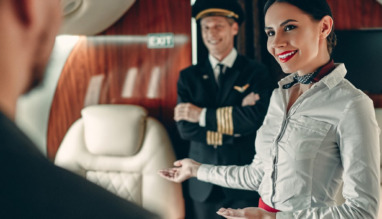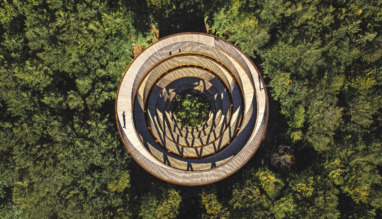Travel Story: a Road Trip Through Denmark’s Architectural Wonderland
From revamped urban districts and sleek bike bridges to futuristic buildings and brand-new museums, a road trip through mainland Denmark and the islands of Funen and Zealand reveals the essence of Danish design and the philosophy that drives it.
Sometime around 2070, someone must have decided to pick up the city of Aarhus—or at least its harbor area on the eastern coast of Jutland—and drop it back into 2024. Especially at night, when the skyline transforms into a spectacular play of lines and lighting, and the futuristic buildings illuminate the scene, you catch glimpses of the future. The men and women strolling along the quays look like they’ve arrived from 2070 as well. It’s possible there’s already a robot or two among them—like that jogging man with a body fit for a Greek demigod, or the blonde Dane with the perfect smile sipping a pricey flat white with her feet in the seawater. Aarhus is one of the final stops on my road trip through Denmark, a journey through cities like Copenhagen and Odense, with design and architecture as its central themes.
The gleaming skyline of Aarhus.
Elevated to an Art Form
What exactly is Danish design? And how do design and architecture relate to one another? To find the answers to these fundamental questions, I first step into the Danish Architecture Center (DAC) in Copenhagen. Kent Martinussen, the director of the DAC, gives me a tour of the center, designed by renowned Dutch architect Rem Koolhaas. Inside, there’s an exhibition tracing the evolution of design and architecture in Denmark.
Kent is a small man with a stylish suit and a scarf around his neck. He’s a captivating speaker, as I quickly discover. “Design is a constant pursuit of improvement,” he explains. “In the 1930s, when the Danish design style began to mature, we started building our welfare society. Our standards are high. After all, we pay a lot in taxes—more than 60% of our income. Naturally, we expect a lot in return. For example, we want prosperity to benefit every Dane. Public spaces should be excellent, as should our workspaces. If you work in an office, we want plenty of natural light so that you’re in a pleasant environment. Architects think about these things. In Denmark, we don’t just see architecture as something functional; we see it as an art form.”
Our conversation is scheduled for about half an hour, but we both lose track of time. I listen intently to Kent’s insights and stories, and two hours later, we’re still talking. Kent has a rare ability: he can zoom out and tell a bigger story that goes beyond his own narrative.
By now, we’ve arrived in one of the exhibit rooms. In front of us are dozens of design chairs, showcasing decades of Danish design. Kent explains their significance in just a few sentences. “We wanted to create something beautiful for ordinary people—not just for offices but for homes too. Because of our climate, we spend a lot of time indoors. We seek a certain coziness in our interiors. We call it hygge. That’s where design comes into play. The Danish chair has become a symbol of this idea.” A photo of President Kennedy hangs on the wall, showing him seated in a Danish chair during a press conference about the moon landing. “That moment really boosted interest in our chairs and in our country.”
In the next room, there’s a selection of lamps. This too is design, and Kent shares a similar story. “You might think a lamp is just a lamp. But we started thinking about how to make lighting as comfortable as possible. Soft, diffused light that’s easy on the eyes. It might seem like a small detail, but it’s these details that reveal the philosophy behind Danish design.”
Kent acknowledges that there are challenges as well. “Copenhagen isn’t green enough—we didn’t consider that sufficiently in the past. For a long time, nature was secondary to architecture. Newer generations want change. Climate, migration, the economy—these are all challenges. Just like the aging population that’s on the horizon. These are problems that need community-driven solutions.”
Danish Daring
A few days earlier, I find myself standing atop the last royal castle in Jutland, overlooking the working-class city of Kolding. Everywhere I look, I see brick smokestacks—seven in total by my count. Rows of workers' houses made from the same red bricks dot the landscape. Koldinghus, the castle, is much more modern inside than one might expect. It has been rebuilt around the old ruins using a removable wooden structure suspended by ropes and cables. Ingeniously designed, this structure is not permanent and can be detached from the original ruins at any time. In one of the halls, pristine white with massive columns, the royal family’s tableware is displayed on a long table, protected by a cage of glass and gold. A longtime staff member named Fin whispers proudly, “At the coronation in 1968, I was a guard. I had to salute.”
A short distance from the castle lies the Trapholt Museum of Modern Art, showcasing art, crafts, and design. The museum boasts a sprawling garden along the Kolding Fjord. Inside, a remarkably long corridor slopes gently downward with the contours of the landscape. “Trapholt is meant to blend into its surroundings,” explains staff member Louise. “The long corridor follows the hill down to the lake behind the museum; the design adapts to the landscape.” This concept—design conforming to the natural environment—is one I will hear repeatedly in the coming days. In the garden at Trapholt, I sit on the grass, gazing at the water. The peace and quiet nearly lull me to sleep—until a manic lawn-mowing robot comes uncomfortably close to my head.
The Trapholt Museum of Modern Art showcases Danish art, crafts, and design.
Afternoons at Koldinghus give way to evenings at the Fjordenhus in nearby Vejle. This time, it’s not a castle but a mysterious harbor building that serves as the headquarters of an investment firm. Designed by Danish-Icelandic artist Olafur Eliasson, the hus features a partially open structure where the wind howls through. If Game of Thrones were set in the future, this modern building would fit perfectly in Westeros. A little further on, The Wave catches my eye—a striking building inspired by the Sydney Opera House. Five white waves stand in a row. The apartments within range in price from $450,000 to $1.6 million. Danish law mandates that housing must remain accessible to all citizens, making this an intriguing example.
I feel a bit uncertain when I come face-to-face with a check-in robot in my high-tech hotel in the same harbor area. There’s not a single human in sight in the lobby. It takes some effort, but the robot and I figure it out. The elevator, my room’s design—everything feels just a bit different from what I’m used to. This becomes a recurring theme over the next few days. The hyper-modern hotels I stay in often challenge me. Sometimes I’m unsure whether I’m facing a window, a door, or a glass wall—or is it an elevator? And if it’s an elevator, how do I operate it? Good design should be functional, intuitive. Perhaps I need to surrender to it—stop overthinking.
Crossing the impressive Great Belt Bridge, a pair of connected bridges spanning the Great Belt Strait, I drive toward Copenhagen. I remember this bridge from the 2022 Tour de France, when it was part of the route and left an unforgettable impression. How does one construct an eleven-mile-long bridge over the sea? What kind of boldness does that require? Boldness must also have been necessary to create the Forest Tower—a 148-foot-tall, hourglass-shaped spiral of steel. Built in the middle of a forest where there was previously little to see, this striking tower forms a perfect circle when viewed from above. Its exact purpose escapes me, but the climb—higher and higher—and the panoramic view of the region will stay with me for years to come.
Flood Risk
In cosmopolitan Copenhagen, I feel as though I’m in a model city—one designed with the quality of life of its residents in mind at every step. Car-free zones dominate the city center, and the sea flows through it like a river. Diving platforms are everywhere, inviting people to leap into the salty water or sunbathe on the wooden decks. It’s a beautiful day, and young Copenhagen parades along the pier. Wooden boardwalks are filled with teenage boys and girls in bikinis, enjoying the sunshine. Ingenious bike bridges connect one quay to another, bustling with cyclists who have overtaken the drivers. Here and there, I come across older neighborhoods, like Christianshavn, where stoic Danes sip coffee in their front gardens. Slowly but surely, they’re being pushed out of the city center. I walk past old warehouses and houses built to look like warehouses.
Copenhagen makes full use of its waterfront.
“Copenhagen is a rich people’s ghetto,” says guide Christiaan, who himself was part of that “ghetto” for a long time. A hip guy who used to work as a journalist, he sold his business a few years ago, pocketing a significant sum. He then launched a tour company, planning to introduce tourists to the city on sleek white design bikes. These bikes, which look fairly ordinary to me, have part of their frame replaced by two thin steel cables. Just before the COVID pandemic shut everything down, Christiaan bought fifty of them. For nearly two years, they sat unused. Now, we’re riding them across the city’s many bike bridges, including Lille Langebro, an eye-catching bridge with curved steel elements that carries around 10,000 cyclists daily.
We ride past NOMA, the world’s best restaurant, as well as its burger joint. Over coffee, Christiaan shares some of Copenhagen’s looming challenges: an aging population and rising sea levels. “We moved out of the city with our two kids, closer to nature,” he says—a story as old as time, repeated in cities everywhere as young families leave urban life behind.
At the ultra-hip Coffee Collective, I indulge in buttery-soft cardamom bread and the most expensive cappuccino I’ve ever had. Staring at the unconventional faucet for a full thirty seconds, I finally figure out how to turn it on. It takes me another twenty seconds to figure out where the water actually comes out, resulting in a minor flood on the wooden floor.
A Perfect World
A massive ship takes me to Aarhus, Denmark’s second-largest city and, in my opinion, the pinnacle of Danish architecture. The city center feels cozy and traditional, with canals and cobblestone streets. But the real spectacle lies in Aarhus Ø, a district under development since 2008 and the recipient of numerous architectural awards. One such prize-winning structure is Isbjerget, a residential complex shaped like an iceberg. The sprawling harbor area is designed with functionality in mind: spots for swimming, waterskiing, benches to gaze out at the sea, and cafés for a quick coffee or glass of wine. In the distance, cranes and cruise ships dominate the horizon. Among the striking buildings is a food hall, one of many found in Danish cities.
As night falls, the lights on the futuristic buildings of Aarhus Ø glitter beautifully. On the streets, I notice clothing racks holding a few dresses, accompanied by a small cash box. You can simply take the clothes if you leave money in the box. It’s an almost perfect world, when you see it like this. But then I recall Kent’s words about the challenges Denmark faces. How do you maintain such high standards for public spaces when an aging population looms and issues like migration come into play?
I step into Kreutzbar, located outside the harbor district. The owner, Bjorn, is a big fan of Berlin. He serves affordable, high-quality coffee. “It has to be affordable,” he says. “Everything here is getting more and more expensive.” Bjorn is a teacher, and he and his girlfriend recently opened the bar as a haven for literature and poetry. It’s a relief to sit here for a while—a space that’s also trendy, but less perfect. “I’m not a fan of the harbor,” Bjorn tells me. “Or of Aarhus Ø. I don’t feel at home there. I think a lot of people in the city share that sentiment.”
The Infinite Bridge, a popular excursion spot, juts out into Aarhus Bay.
The ever-present sea
At the end of my road trip, I cross the mainland. Rolling green pastures, the occasional field of solar panels with sheep grazing in between. And then, there it is again—the sea. A Danish law dictates that all Danes must have access to their coastline. Looking back, I realize I ended every evening by the water. Everywhere, I found a lovely spot by the sea. In Vejle, I sat in the Fjordenhus, my legs dangling over the quay. In Copenhagen, I wandered along the water in the trendy Nordhavn district. In Odense, I sat on a pier where four people were awkwardly salsa dancing—having just met through an app. In a run-down fishing village on the way to Aarhus, I ate cod. And now, I’m gazing out over the North Sea. German tourists in RVs and caravans have made their way here. An older couple has driven their camper onto the beach and sits in camping chairs, their backs to the sea.
Here on the west coast, life is quieter. The countryside stretches out around me until I reach Ribe, Denmark’s oldest town. A city steeped in tradition, it boasts an old church and a square where the town watch makes nightly rounds. It sounds like a tourist attraction, and it is. Yet, when the town watchman steps into the restaurant where I’m dining, still dressed in uniform at five minutes to eight, it feels special. He’s paid by the city’s museums and the local government. Singing as he walks his route, his voice reassures the townsfolk that he’s there and they can sleep safely.
My final stop is at the Wadden Sea Centre, roughly 150 miles from Groningen as the crow flies. At first, I can’t spot the building. It blends seamlessly into the coastal landscape. Its low profile and camouflage colors mirror the dunes and the gray hues of the Wadden Sea. The sprawling roof is made of reeds. Klaus Melbyei, the director, explains, “We wanted the museum to ‘grow’ into the landscape. Aesthetically, it had to match—the dike and the sea behind it. Nothing too conspicuous, no bright colors. An iconic building, but understated. We didn’t want it to be taller than Ribe’s church. Here, you can stand on the dike and, metaphorically speaking, watch a hare run for two weeks.” Klaus, in his sixties, has a kind gaze, shorts, and sandals. His phone’s screen shows a picture of his three-year-old grandson.
Suddenly, Klaus reaches into an aquarium and tries to grab a large flounder camouflaged in the sand. The fish darts away. “In Denmark, we believe nature should be touched. That’s the purpose of this center: teaching people about the Wadden area, about connecting with nature. We want to bring the Wadden Sea into people’s hearts. The average Dane spends just ten minutes a day in nature. Kids have no idea what to do when they’re outside—they get bored. Here, we teach them how to enjoy the outdoors. Sometimes, I take a group into the dunes for a couple of hours. We sit quietly and watch the tide change and how the waterfowl adapt their behavior. Or we go out and collect oysters…”
After my conversation with Klaus, I step onto the dike and stare out at the sea for a while. A timeless view, offering a moment of calm after all the dazzling, impressive, and inevitable visions of the future.




